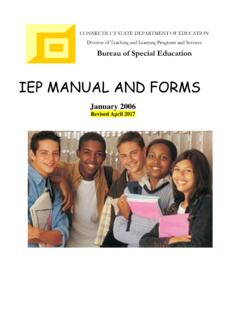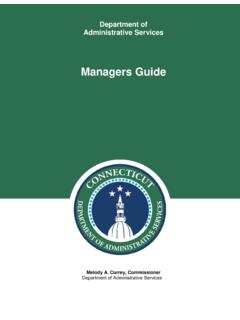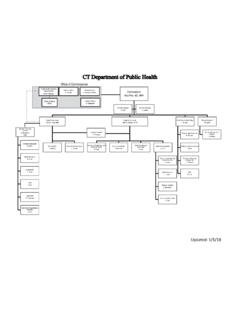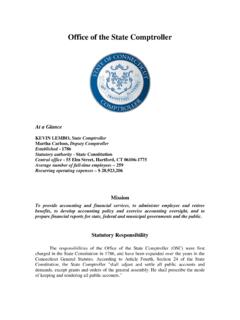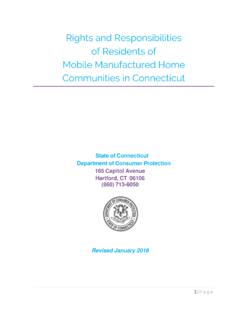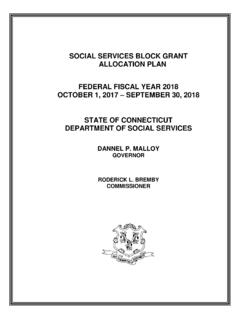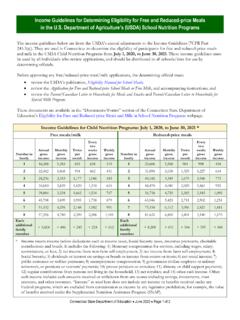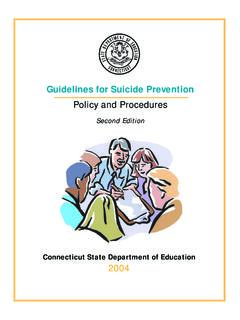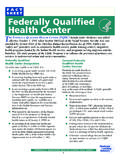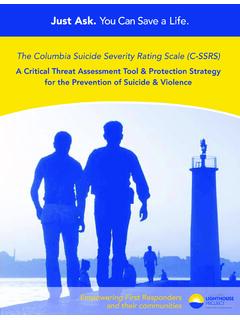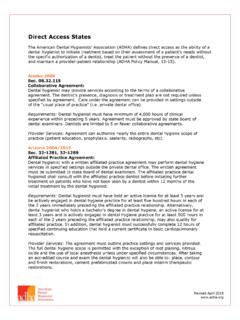Transcription of Student Participation in Distance Learning - Connecticut
1 Student Participation in Distance Learning : Device/Connectivity Needs, Effective Strategies, Challenges, and State Supports Needed Results from a District Survey Conducted on Behalf of the Learn from Home Task Force June 2020 Table of Contents Executive Summary .. 3 Introduction .. 5 Data Collection .. 5 Results .. 7 Approach to Distance Learning .. 8 Extent of Student Participation .. 9 Barriers to Participation : Devices Internet Access, and Family, Health, Trauma Issues .. 11 Effective District Strategies .. 15 Challenges .. 17 Supports Needed from State of Connecticut .. 23 Conclusion .. 28 Student Participation in Distance Learning : Device/Connectivity Needs, Effective Strategies, Challenges, and State Supports Needed (June 2020) Page 3 of 28 Executive Summary On behalf of the Learn from Home Task Force (LHTF), the Connecticut State department of education (CSDE) conducted a brief survey to gauge the approaches to Distance Learning during the COVID-19 pandemic, including the extent of Student Participation in those offerings and the barriers (especially devices and connectivity) to greater Participation .
2 In addition, the survey sought district perspectives on effective strategies to increase Student Participation in Distance Learning , the most challenging areas for getting fuller Student Participation , and the specific supports the State of Connecticut can provide to increase Student Participation in Distance Learning . Here s a brief summary of the results: Survey responses were received from 170 ( percent) of the 201 potential school districts. These 170 districts enrolled percent of the total statewide Student population and percent of all students statewide who are eligible for free- or reduced-price meals. Therefore, this survey can be considered as representative of the entire statewide population Over 90% of students who participated in Distance Learning after class cancellations due to COVID-19 participated through technology-based online Learning while fewer than 10 percent participated through other methods ( , printed Learning materials/packets, 1:1 phone calls, wellness checks).
3 Over 74 percent of all students (approximately 391,000 students ) are fully participating in the Distance Learning offerings of the district. Another 14 percent (approximately 76,000 students ) are partially participating, 8 percent are minimally participating (approximately 40,000 students ), and 4 percent have not participated (approximately 21,000 students ). Tens of thousands of students statewide are experiencing the following barriers to greater Participation in Distance Learning : o Access to a device in the home nearly 10 percent (around 50,000 students ) o Internet access in the home nearly six percent (over 29,000 students ) o Family, health, and trauma issues over 17 percent (nearly 92,000 students ) In almost all measures on this survey, the 10 Opportunity Districts reflect the greatest challenges with Participation , and evidence disproportionately greater need in the areas of devices, connectivity, and family, health, trauma issues.
4 Student Participation in Distance Learning : Device/Connectivity Needs, Effective Strategies, Challenges, and State Supports Needed (June 2020) Page 4 of 28 o Nearly 27 percent of the students in these districts are receiving Distance Learning through offline methods, as compared to only 9 percent in the remaining 23 Alliance Districts and percent statewide. o Only around 48 percent of students in these 10 districts are participating fully in the Distance Learning program as compared to over 75 percent in the remaining 23 Alliance Districts and over 74 percent statewide. o Though these 10 districts enroll about 20 percent of the total Student population statewide, they account for 44 percent of all students statewide needing devices, 35 percent of all students statewide needing internet access in the home, and 37 percent of all students statewide experiencing family, health, and/or trauma issues.
5 Strategies deemed effective by the districts include individual contact with students and families, delivering of technology and technological support, case management and individual/family interventions, engagement of students through fun social activities, live lessons and interactions with teachers, and the use of Learning management programs. The greatest challenge to getting fuller Participation in Distance Learning was the ongoing challenge faced by parents/guardians who may be working full time, feeling overwhelmed, or dealing with food/income security issues to support their child with school work. In some cases, there were challenges in actually making contact with some families. Other challenges included working with at-risk students , technology access (both devices and connectivity), supporting special education and English learners, materials and professional Learning , specials including arts and physical education , and managing the specialized circumstances facing younger and older students .
6 Specific supports desired from the State of Connecticut to increase Student Participation include technology, state guidance on a variety of topics including Distance Learning standards and school reopening, curriculum and professional Learning resources, and supports for families. Student Participation in Distance Learning : Device/Connectivity Needs, Effective Strategies, Challenges, and State Supports Needed (June 2020) Page 5 of 28 Introduction When in-person classes in all public schools were cancelled on March 17, 2020 due to the COVID-19 pandemic, instruction full-time shifted to remote Learning from home. Governor Lamont and education Commissioner Cardona established the Learn from Home Task Force (LHTF) to lead the effort to ensure every Student has access to high-quality Learning content at home.
7 The LHTF s first task was to lead the safe, efficient and timely distribution of two recent philanthropic donations intended to advance equitable access and support continuity of education at home, including the gift of up to 60,000 laptops to high school students by the Partnership for Connecticut as well as more than 185,000 high-quality, Scholastic book packs by the Nooyi Family for PK-8 grade students . The Connecticut State department of education (CSDE) also made available numerous digital Learning resources for integration by districts into their programs; in addition, the CSDE hosted a multi-part webinar series that showcased how a range of Connecticut districts had implemented teaching and Learning at a Distance .
8 Key topics such as Student engagement, balancing asynchronous and synchronous Learning , online teaching practices, professional Learning , rigorous content, formative assessment, special populations, socioemotional support, connectivity, and security were discussed. As the 2019-20 school year draws to a close, the LHTF and the CSDE are interested in getting high-level answers to following three essential questions: 1. What approaches to Distance Learning ( , online Learning versus other methods such as printed Learning materials/packets, 1:1 phone calls, wellness checks) were being employed by districts to continue delivering educational opportunities to students ? 2. To what extent did students participate in the Distance Learning programs offered by their district?
9 3. To what extent did students access to devices in the home, access to the internet, and/or other family, health, or trauma issues become critical barriers to greater Participation in Distance Learning ? Data Collection The CSDE designed a simple survey to gather district-level estimates on the above three questions. In addition to the quantitative estimates, open ended questions sought district perspectives on effective strategies to increase Student Participation , the most challenging areas for getting fuller Student Participation , and the specific supports the State of Connecticut can provide to increase Student Participation . The survey was sent to all local and regional school superintendents, public charter school directors, headmasters of endowed Student Participation in Distance Learning : Device/Connectivity Needs, Effective Strategies, Challenges, and State Supports Needed (June 2020) Page 6 of 28 academies, executive directors of regional education service centers (RESCs), and the state school districts including the CT Technical education and Career System, Unified School District #1 and #2.
10 Survey responses were received from 170 ( percent) of 201 potential school districts (see Table 1). These 170 districts enrolled 489,403 students based on the October 1, 2019 Student enrollment count; this represents percent of the total statewide Student population of 527,829. Of the 228,357 students statewide who are eligible for free- or reduced-price meals a common proxy measure for socio-economic status an even greater percentage ( percent) were enrolled in districts that responded to the survey. Table 1: District Representation in the Survey Responses Received Districts All students Free- or Reduced-Price Meal Eligible students District Type Total # Respond-ed State Total Percent Respond-ed Total # Respond-ed State Total Percent Respond-ed Total # Respond-ed State Total Percent Respond-ed Alliance: Opportunity Districts 10 10 106,776 106,776 77,596 77,596 Alliance: Non-Opportunity Districts 23 23 113,417 113,417 66,452 66,452 All Other Local/Regional and Endowed Academies 113 136 238,219 270,966 54,223 61,202 RESCs, Public Charters, State Districts incl.
